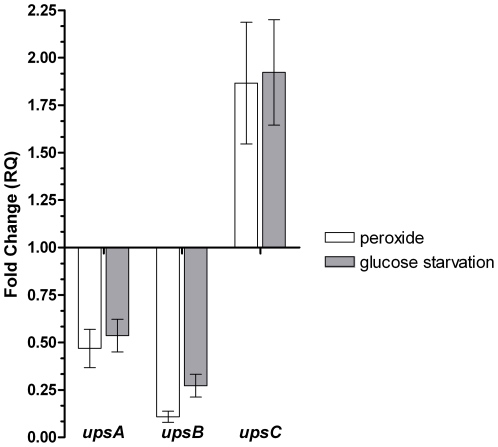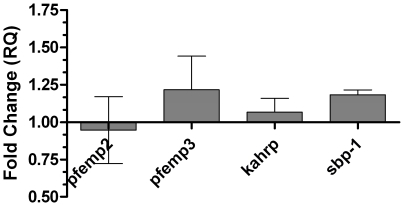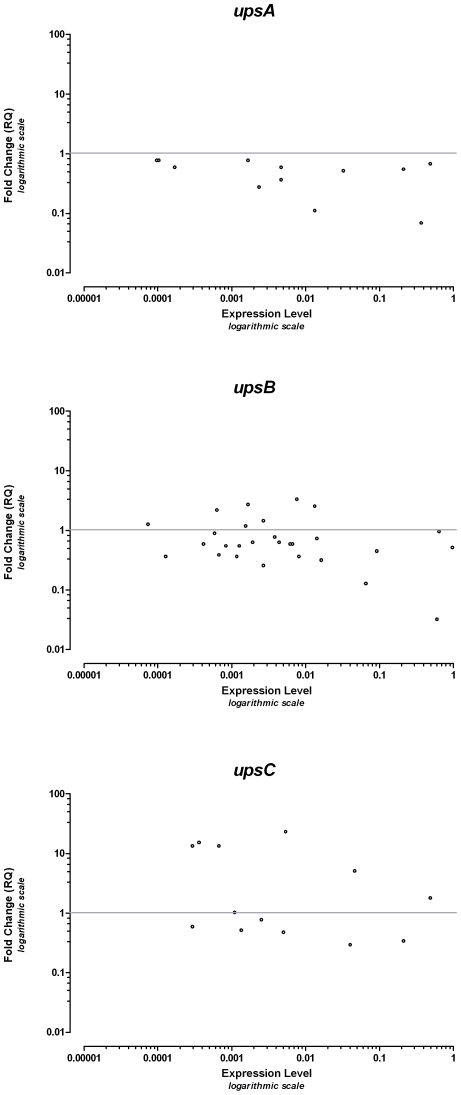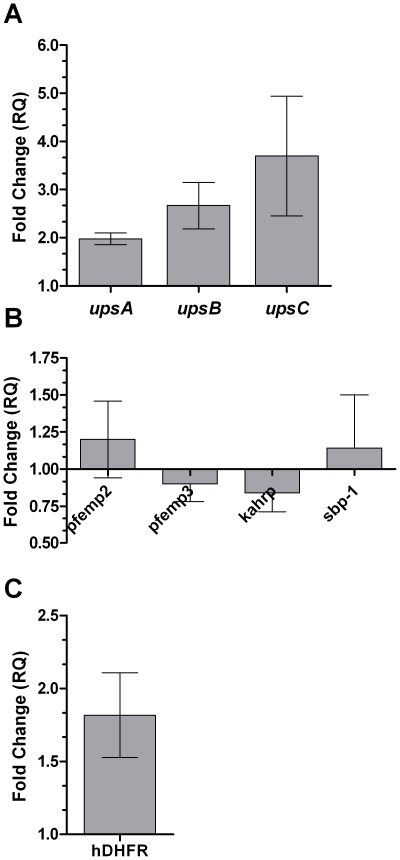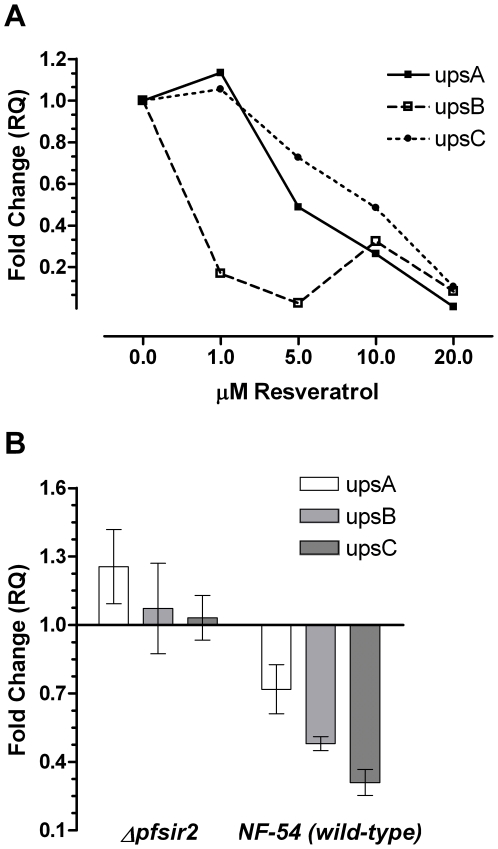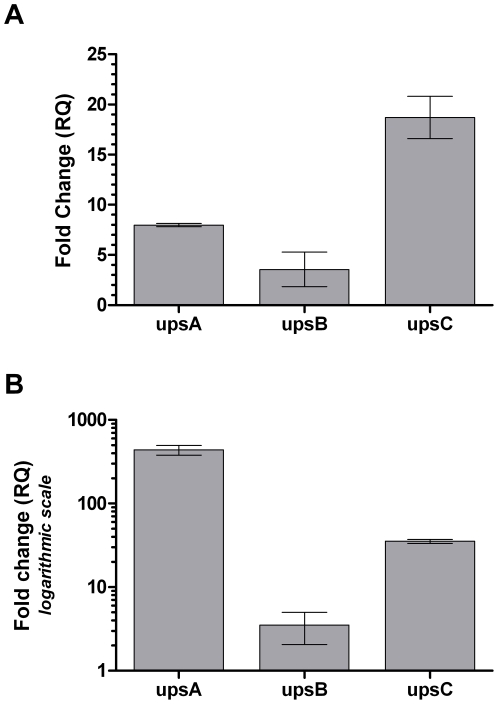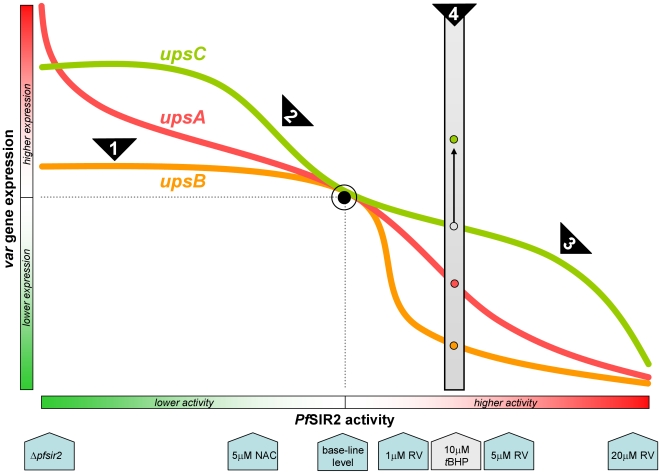Abstract
1% of the genes of the human malaria causing agent Plasmodium falciparum belong to the heterogeneous var gene family which encodes P. falciparum erythrocyte membrane protein 1 (PFEMP1). This protein mediates part of the pathogenesis of the disease by causing adherence of infected erythrocytes (IE) to the host endothelium. At any given time, only one copy of the family is expressed on the IE surface. The cues which regulate the allelic exclusion of these genes are not known. We show the existence of a differential expression pattern of these genes upon exposure to biological stress in relation to their positional placement on the chromosome – expression of centrally located var genes is induced while sub-telomeric copies of the family are repressed - this phenomenon orchestrated by the histone deacetylase pfsir2. Moreover, stress was found to cause a switch in the pattern of the expressed var genes thus acting as a regulatory cue. By using pharmacological compounds which putatively affect pfsir2 activity, distinct changes of var gene expression patterns were achieved which may have therapeutic ramifications. As disease severity is partly associated with expression of particular var gene subtypes, manipulation of the IE environment may serve as a mechanism to direct transcription towards less virulent genes.
Introduction
The mechanisms that have evolved for the exclusive expression of a particular gene from a multi-gene family differ between various organisms and cells, examples being the expression-linked site in the trypanosome antigenic variation VSG family [1], the B-cell/TCR rearrangement machinery [2] and the olfactory receptor repertoire [3]. P. falciparum harbors several such multi-gene families [4]. Of these, the most widely studied one, the var gene family, encodes PFEMP1 - a polymorphic molecule of both clinical importance and of great scientific interest as its regulatory mechanism is unlike any other system involved in allelic exclusion [5].
During the erythrocytic stage of its lifecycle, P. falciparum exports a plethora of proteins to the surface of the IE, many of these are involved in the modification of the IE cytoskeleton and membrane to create the characteristic knob structure on the IE surface [6]. PFEMP1 protrudes from the knob to engage with various endothelial receptors, such as ICAM-1, CD36 and CSA, causing the cytoadherence of the IE to the endothelial cells and its sequestration in the microvasculature - the dire clinical complications of this disease, such as cerebral malaria and placental malaria, are the consequence of this phenomenon [7]. PFEMP1 is encoded by the 59 member var gene multifamily, and it is accepted that in an individual parasite, at any given moment, only one var gene is expressed [8]–[10]. This exclusively expressed gene can be switched to an alternative member of the var repertoire thereby achieving antigenic variation and effectively avoiding host immune system clearance. The var genes are divided into three main subtypes (upsA, upsB and upsC), based on their 5′ upstream promoter sequences [4], [11], [12]. UpsA-type var genes are located in subtelomeric regions, upsB-type var genes are located subtelomerically with many of them immediately adjacent to the telomeres and upsC-type var genes are found in chromosome-internal clusters. Interestingly, these subtypes have a clear clinical significance as disease phenotype is linked to the subtype expressed. For instance, severe malaria was correlated with the expression of upsA [13] or upsB [14] or both [15] var gene subtypes whereas asymptomatic malaria was correlated with the upsC subtype [14]. The regulation of var gene expression and the mechanisms responsible for maintenance of allelic exclusion occur at the transcriptional level [16]. Various multilayered epigenetic mechanisms have been implicated in this transcriptional control [17]: perinuclear locus repositioning of a var gene to a transcriptionally active site [18], [19], repression activity of the intron of the expressed var gene [20]–[22] and modification of chromatin structure [23]–[25]. In regard to the latter, an orthologue of the S. cerevisiae NAD+ dependent histone deacetylase (HDAC) sir2 (Silencing Information Regulator 2, also known as sirtuin), involved in alteration in chromatin structure was identified in P. falciparum and termed pfsir2 [24]. It was shown to associate with the telomeric rep20 sequences and induce deacetylation of histone H4 complexes thus spreading gene repression ∼50 kb into chromosome internal regions, regions that include many var genes. Additionally, it was found to be released upon var gene activation concomitantly with acetylation of histone H4. This data implicates pfsir2 and the telomere positional effect (TPE) as central players in var gene regulation. Interestingly, an additional plasmodial HDAC, termed psir2B, was recently found to exclusively suppress expression of the upsB subype [26].
While the data which accumulated in recent years open new doors in our understanding of var gene regulation and allelic exclusion, several questions still remain unanswered. Is the selection of a particular var gene random or is it dependent on other cellular conditions? More specifically, what are the cues involved in determination of the var positioned for exclusive expression? Finally, does the expression of certain var genes confer a survival advantage to the parasite?
We hypothesized that transcription of var genes, as encoders of an external protein which interacts with its surroundings, may be differentially affected by environmental conditions the parasite encounters throughout it's complex life-cycle.
Materials and Methods
Parasite culturing and synchronization
The in vitro culturing and synchronization of P. falciparum NF-54 isolate was carried out by standard protocols as described previously [27]. Briefly, the parasites were cultured in flasks at 37°C and 5% hematocrit in RPMI 1640 medium supplemented with human plasma (A+ or AB+), 50 µg/ml gentamycin, 25 mM HEPES, and 0.25% sodium bicarbonate in an atmosphere of 5% O2, 5% CO2 and 90% N2. When cultures exceeded parasitemia of 10%, they were diluted to 3%. Prior to experimentation, parasite cultures were synchronized to early ring stage using 5% sorbitol, the procedure preformed twice consecutively ensuring removal of all parasites not at the ring stage.
We used two parasite lines which were genetically manipulated. The first, 3D7/upsC, is a 3D7 parasite carrying a pHBupsC plasmid as an episome [21]. This plasmid contains genes coding for blasticidin deaminase (bsd) and human dihydrofolate reductase (hdhfr), conferring resistance to blasticidin-S and WR99210 (WR) respectively. The transfected parasites were grown with 2 µgml−1 blasticidin-S added to the culture medium to obtain parasites carrying episomes, and then continuously exposed to 4 nM WR for at least 40 generations to guarantee selection of parasites exclusively expressing the episomal hdhfr. The second line used is a pfsir2 knockout (Δpfsir2) [23].
Stress induction
Ring-stage parasites (6 hours post synchronization) were exposed to two forms of stress inducing conditions: oxidative stress (10 µM of tert-butylhydroperoxide [tBHP] for 4 hours) and glucose deprivation (4 hour culture in the presence of 1.95 g/l glucose, 50% of the normal concentration), immediately followed by RNA extraction. The timing of this analysis at 10 hours post synchronization coincides with the peak of var gene expression determined by a time-curve assay (data not shown). This was performed by qPCR analysis of total var gene expression using var universal primers at 10, 14 and 24 hours post-synchronization. The stress conditions used in these experiments did not affect the vitality and growth of the parasites as judged by a hypoxanthine incorporation assay and examination of parasitemia levels.
Pharmacological agents
The effect of two compounds was examined – resveratrol (RV) and N-acetylcysteine (NAC). A 1 M stock solution of RV was prepared in DMSO from powder (Sigma) which was further diluted in double-distilled water. RV was freshly prepared for each experiment. NAC, supplied as liquid (CellTech) was diluted in double-distilled water. Synchronized ring stage parasites were exposed to either agent at 2 hours post synchronization for 8 hours with RNA extraction at 10 hours post synchronization.
Hypoxanthine incorporation assay
At 18 hours post-stress induction, parasites were cultured for 18 hours in a 96 well plate at a hematocrit of 1.5% and 1% parasitemia in the presence of [3H]hypoxanthine (0.5 µCi per well). Cells were harvested using an Inotech cell harvester and radioactivity counted in a β-scintillation counter.
RNA extraction and cDNA synthesis
Free parasites were obtained from the IE by lysis with 0.05% saponin and pelleted by centrifugation. Purification of total RNA from parasite pellets was carried out using Tri-Reagent in accordance with the manufacturer's protocol. Carry-over DNA was eliminated by DNase treatment (Turbo DNA-free, Ambion) and its absence was validated by PCR using primers for the 18S ribosomal RNA gene. Only completely DNA-free total RNA samples were used for cDNA synthesis (ABgene ConvertIT kit in accordance with the protocol supplied by the manufacturer) using random decameres as primers.
Gene expression analysis
Relative gene expression was calculated using the quantitative real-time PCR (qPCR) method with primers designed for the conserved upsA, B and C 5′ upstream sequences [14], individual var genes [28], 18S ribosomal subunit (forward 5′-GCTGACT-ACGTCCCTGCCC-3′; reverse 5′-ACAATTCATCATATCTTTCAATCGGTA-3′) the seryl tRNA synthetase (forward 5′-TGGAACAATGGTAGCTGCACAAA-3′; reverse 5′-ATGGGCGCAATTTTTCAGGA-3′) and for hdhfr (forward 5′- GAATCACCC-AGGCCATCTTA-3′; reverse 5′- GCCTTTCTCCTCCTGGACAT-3′). qPCR was performed on the ABgene thermocycler platform with the ABsolute SYBRgreen ROX mix (ABgene), 1 ng of cDNA template and 100 nM gene specific primers. The 18S ribosomal subunit and the seryl tRNA synthetase genes were used as endogenous controls. These primers and the primer for hdhfr were examined for efficiency, displaying an amplification slope of −3.33±0.3 and r2≥0.98. Data analysis was performed using the ΔΔCT method with the ABgene thermocycler software. Expression analysis experiments were repeated between 3 to 6 times, each experiment in triplicates.
Results
Effect of environmental stress on the expression of var genes
Synchronized NF-54 ring stage parasites at 6 hours post-synchronization were exposed to two forms of stress: oxidative, via exposure to tBHP and nutritional deprivation by culturing the parasite in the presence of half of the normal glucose concentration. Stress was applied for 4 hours immediately followed by total RNA extraction. The change in ups var gene subtype expression was examined utilizing qPCR with general primers for the upsA, B, and C subtypes. The results presented in Fig. 1 show the change in the ups subtype expression pattern upon exposure to the two forms of stress. Subtelomeric upsB subtype expression is repressed to the highest extent, with a more moderate repression of subtelomeric upsA subtype expression. This contrasts the definite induction of expression of the upsC subtype located in the central regions of the chromosome.
Figure 1. The relative change in expression of the ups A, B, and C var subtypes upon exposure to stress in NF-54 parasites.
Synchronized ring stage parasites were exposed to a 4 hour pulse of stress inducing conditions (either 10 µM of tert-butylhydroperoxide or cultivation in the presence of 50% of the normal glucose concentration). cDNA prepared from RNA isolated from these parasites was analyzed utilizing qPCR with ups-specific primers. Results are expressed as fold change in comparison to an unexposed control (Relative Quantification, RQ). Error bars represent mean ± SEM.
In order to examine whether this seemingly positional pattern is unique to var genes or whether it is a general positional-dependent pattern, we examined the effect of stress on other exported non-var genes. The genes chosen are all placed at various distances from the telomeres and are all exported to compartments unique to an IE - either the knob structure (PFEMP2, PFEMP3, KAHRP) or the Maurer's cleft (SBP-1) [29]. SBP-1, PFEMP3 and KAHRP are also involved in the positioning of PFEMP1 on the IE membrane [30]–[32]. As shown in Fig. 2, the expression of these genes was not substantially affected by the stress, suggesting that within this subset of genes, the effect of stress is var gene specific.
Figure 2. Analysis of expression of exported non-var genes upon exposure to 10 µM tBHP in NF-54 parasites.
Stress induction, cDNA production and qPCR analysis were performed as described in the legend to Fig. 1. Error bars represent mean of triplicates ± SEM.
To study whether the differential effect of stress on var gene subtypes is apparent after several generations, the effect of oxidative stress on the expression of 59 individual var genes was examined. This was performed under slightly different conditions. Synchronized parasites were exposed to 500 nM tBHP for 6 days and then re-synchronized to ring form. RNA was extracted 10 hours later and qPCR analysis of the expression of each individual var gene was performed. In order to analyze whether the changes observed in this set of data correlate with the phenomenon seen when using the general ups primers (Fig. 1), we plotted this data as fold-change versus level of expression for each individual var gene (Fig. 3). This demonstrates, in agreement with the initial results, that throughout the repertoire of var genes the expression of the subtelomeric genes (Fig. 3A, B) are mostly repressed whereas genes of the central region are mostly induced (Fig. 3C).
Figure 3. Fold change of individual var genes upon exposure to oxidative stress plotted against expression levels.
The data was plotted as logarithmic values of RQ versus the base-line logarithmic level of expression of each of the var genes. Marks above the horizontal line represent genes whose expression is induced and those below the line represent genes whose expression is reduced. Panels A, B and C show the breakdown to the respective ups subtypes.
ups promoter sequence or chromosomal position?
We further pondered whether this differential effect on var genes is due to the difference in the upstream sequence of the subtypes' promoters or whether it is due to their position along the chromosome. To address this question, we used the two genetically modified parasite lines described in Materials and Methods . We hypothesized that pfsir2 may act as a leading candidate for involvement in the stress response of var genes. In light of this possibility, when repeating the exposure to stress on a pfsir2 knockout line, a different pattern was observed – stress up-regulated all three subtypes (Fig. 4A). No significant change was observed when examining the other exported genes (Fig. 4B) leading to the conclusion that the upsA and upsB down-regulation upon stress exposure is a pfsir2, hence a positional, dependent process.
Figure 4. Analysis of expression of var and non-var exported genes upon exposure to oxidative stress in genetically modified parasites.
A. The relative change in expression of the ups A, B, and C var subtypes upon exposure to 10 µM tBHP in Δpfsir2 parasites in relation to unexposed Δpfsir2 parasites. B. Analysis of expression of exported non-var genes upon exposure to oxidative stress in Δpfsir2 parasites. C. Analysis of expression of hdhfr – the gene under control of an upsC element in the 3D7/upsC transgenic line – upon exposure to 10 µM tBHP. Stress induction, cDNA production and qPCR analysis were performed as described in the legend to Fig. 1. Error bars represent mean of triplicates ± SEM.
To examine whether the stress induced up-regulation of var genes is independent of chromosomal positioning we used the 3D7/upsC parasites transfected with the pHBupsC episomal DNA plasmid which caries a gene encoding hdhfr driven by an upsC promoter. Studying the transcription level of hdhfr upon stress exposure was used as a tool to analyze var promoter function uncoupled from its chromosomal context. Stress induced the expression of the plasmid's hdhfr (Fig. 4C), suggesting that up-regulation of upsC var genes under stress is also a promoter (sequence) – dependent event.
Response of var genes upon modulation of pfsir2 activity
The results obtained hitherto implicate pfsir2 as a crucial factor involved in repression of subtelomeric copies of var genes under stress-inducing conditions. It was of interest to further examine the response of var gene expression upon isolated modulation of pfsir2 using well studied chemical agents.
To study the effect of pfsir2 activation we assessed the effect of resveratrol, a polyphenol found in red grapes and peanuts, which was found to activate sir2 in various eukaryotes [33], [34]. Fig. 5A demonstrates a dose dependent repressive response of all the var gene subtypes to an eight hour exposure to resveratrol. This effect is not observed when repeating the exposure on the pfsir2 knockout line (Fig. 5B), suggesting that the resveratrol induced down-regulation of var genes is indeed a pfsir2 dependent process.
Figure 5. The effect of resveratrol on var gene expression.
A. Analysis of expression of var subtypes upon exposure to RV in wild-type parasites. Synchronized ring stage parasites were exposed for 8 hours to various concentrations of RV. B. Analysis of expression of var subtypes upon exposure to 10 µM RV in wild-type and Δpfsir2 parasites. Synchronized ring stage parasites were exposed for 8 hours to 10 µM RV. cDNA production and qPCR analysis were performed as described in the legend to Fig. 1.
We rationalized that if stress-inducing conditions activate pfsir2 (discussed below), then protection from stress might decrease pfsir2 activity. To study this we used a well-known antioxidant widely used in clinical settings - N-acetylcysteine (NAC) - albeit no studies demonstrate that it inactivates sirtuins. When exposing synchronized parasites to an 8 hour pulse of 5 µM NAC, upsA and upsC sub-types are substantially induced while upsB genes are only negligibly up-regulated (Fig. 6A). This pattern is similar to the comparative pattern obtained when examining var gene expression in the Δpfsir2 line (Fig. 6B), suggesting that NAC indeed inactivates pfsir2.
Figure 6. The effect of pfsir2 inactivation on var gene expression.
A. Change of expression of ups subtypes in NAC exposed wild-type culture in relation to an unexposed culture. Synchronized ring stage parasites were exposed to 5 µM of NAC for 8 hours. B. Relative expression of ups subtypes in the pfsir2 knock-out line in relation to the wild-type line under normal culturing conditions. Note that y axis is in logarithmic scale. cDNA production and qPCR analysis were performed as described in the legend to Fig. 1.
Discussion
The focus of our study was to examine the effect of stress that the parasite encounters throughout its lifecycle on the expression of var genes. The parasite is exposed to oxidative stress in its natural dwellings – the IE. Increased exposure to reactive oxygen species are also found in the pulmonary circulation and possibly when encountering immune cell surveillance. Decreased glucose levels are one of the hallmarks of severe malaria as patients can develop hypoglycemia as low as 50 mg/dl. It is therefore reasonable to assume that the parasite has evolved mechanisms to deal with such forms of metabolic perturbations.
We hypothesized that the differences in upstream promoter sequence and chromosomal location of the var genes might influence their expression pattern under stress-inducing conditions. Hence, the qPCR was initially performed with primers which recognize the common upstream promoter regions of the 3 main ups subtypes. Upon short exposure to oxidative stress or glucose deprivation, expression of the subtelomeric upsB and upsA subtypes are repressed while that of the centrally located upsC subtype is induced. In order to examine whether the effect is carried over several generations we performed the gene expression analysis after several days of exposure to low-level oxidative stress, this time studying expression of each member of the var gene repertoire. Exposure to oxidative stress causes a change in the expression pattern of the var genes, with a general trend of inducing the expression of upsC var genes while repressing the upsA and upsB subtypes, corroborating the results obtained with the general ups primers. The differential pattern spans all levels of expression – affecting genes of high and low levels of expression. This points to the possibility that the response to stress is achieved in a manner that does not involve the proposed allelic exclusion mechanism(s) and acts as a novel, additional layer of var gene regulation. The lack of effect of oxidative stress on a representative group of other exported genes with topological and functional relationships to the PFEMP1 suggests that the stress inducing conditions we examined affect the var gene family in a specific and organized manner and not as part of a general transcriptional response of the parasite to stress.
Taken together, these results all point to the fact that there seems to be a certain stability to the upsC sub-type as it is preferentially expressed under changes in environmental conditions. Several recently published studies are in accordance with our findings: a) Exposure of parasites to febrile temperatures showed an increase in the expression of 5 var genes [35], 4 of them belonging to the upsC group. b) At the initiation of gametogenesis, an event influenced by environmental signals [36], there was a switch from the existing var expressed during the asexual stages to a var from the upsC subtype [37]. c) During the period of adaptation of parasites to culture, there was a general down regulation of all var genes. However, in those who display upsA, D and E sequences, the rate of down regulation was significantly faster than the genes flanked by upsB and C [38]. d) Studies of switching rates also showed that expression of var genes located in the central regions of chromosomes are remarkably stable and that they rarely undergo transcriptional switches in the absence of selection, whereas parasites expressing subtelomerically located var genes readily switch them to alternative var loci [39].
The phenomenon of the differential effect of stress on centrally-positioned and telomerically-placed var genes raises the question whether this is based on sequence of the upstream promoters of the genes or their position along the chromosome. This question was answered by studying the response of pfsir2 knock-out and 3D7/upsC strains to oxidative stress. These experiments show that the up-regulation of var genes upon exposure to stress is most likely a sequence-dependent event while down-regulation is probably a positional-dependent event, the net effect of both processes results in the differential, positional-dependent pattern observed upon exposure to stress.
We further examined the effect of pfsir2 on var gene expression by modulating its activity thereby adding new insights regarding the regulation of this enzyme on the expression pattern of the ups subtypes. Resveratrol, a sirtuin activator, decreased expression of all var gene subtypes, regardless of chromosomal position, in a dose- and pfsir2-dependent manner. This finding suggests a pfsir2 modulation over upsC genes, a conclusion that is also apparent from the examination of ups expression in the Δpfsir2 line using qPCR (Fig. 6B) and from previous work studying var expression using DNA microarrays in Δpfsir2 [23]. Both experiment show upsC gene up-regulation in the absence of the TPE. However, in a chromatin immuno-precipitation (ChIP) study preformed by Scherf and colleagues [24] using anti-pfsir2 antibodies, pfsir2 binding was demonstrated to occur in telomeric regions with repression of upsB expression while it was also clearly shown to not bind or have a direct effect on upsC var genes (upsA genes were not studied). This discrepancy can be resolved by predicting the existence of additional layer(s) of control, a likely possibility being a transcription factor under direct control of pfsir2 which exclusively activates upsC var genes. The activity of such a transcription factor on upsC will not be apparent when utilizing a ChIP assay while it's un-repressed effect will easily be demonstrated when examining expression levels of upsC var genes in a pfsir2 knock-out.
In contrast to the activation of pfsir2 using resveratrol, experimentation with NAC presents a var expression pattern consistent with pfsir2 deactivation as it is similar to the pattern of basal var expression observed in the Δpfsir2 line – prominent up-regulation of upsA and upsC var genes with minimal effect on upsB (Fig. 6B). Review of the literature shows that a relationship between NAC and sirtuin inhibition was never studied, however such a relationship seems plausible as NAC, an antioxidant, could (directly or indirectly) reduce NAD+ to NADH thus resulting in NAD+ depletion. As pfsir2 is a NAD+ dependent enzyme [40], this would result in decreased activity of the enzyme.
When incorporating all the data obtained in this study, an integrated picture of the pfsir2-dependent orchestrated response of var genes to changes in the external environment can be built (schematically presented in Fig. 7):
Figure 7. Schematic representation of the proposed theory of var modulation by pfsir2.
This schema summarizes the main findings and theories put forward in this work. pfsir2 plays a dominant role in var gene regulation, its level of activity differentially determining the extent of var gene expression. x axis represents pfsir2 activity, y axis represents relative var expression. This figure does not represent quantitative relationships. See text for further explanation. Arrowheads at bottom row show the main experiments involved in the establishment of this theory.
When pfsir2 is inactivated it releases the sub-telomeric var genes from its inhibitory effect. However, upsB var genes are not up-regulated de facto due to the existence of the additional upsB-specific HDAC (black arrow 1 in Fig. 7). As for upsC, this subtype is not under direct control of pfsir2, yet its expression is affected by a predicted transcription factor which is under pfsir2 control. When pfsir2 activity is reduced, the proposed transcription factor is freed of repression thus allowing increased expression levels of upsC genes (black arrow 2 in Fig. 7).
When pfsir2 is activated, it binds to the telomere-associated rep20 sequences and propagates inhibition into the chromosome. The end effect of activated pfsir2 is dependent on the intensity of activation. At low levels of pfsir2 activation, the inhibition will be most prominent on the upsB subtype var genes as they are closest to the telomeres. At higher levels of pfsir2 activation, the inhibitory effect of pfsir2 increases as it propagates deeper into the chromosomal sequence to encompass the upsA var genes. When pfsir2 activity is highest, it represses the putative upsC transcription factor thus resulting in the addition of upsC genes to the inhibitory effect of pfsir2 (black arrow 3 in Fig. 7). In other words, pfsir2 activation has a “dose-responsive” effect – increasing levels of pfsir2 activity first affect upsB genes, followed by upsA genes and lastly upsC genes. Careful examination of the data obtained with resveratrol (Fig. 5A) show precisely such a dose-dependent pattern: At 1 µM only upsB is down-regulated (>80%) with no effect on the other sub-types, at 5 µM upsA is also down regulated (>50%), and at 20 µM all three subtypes are equally repressed.
This model also contributes to the explanation of the response of var genes to stress exposure (black arrow 4 in Fig. 7): Stress inducing conditions would cause induction of var genes regardless of their subtype classification or their chromosomal position. However, stress also activates pfsir2 (in S. cerevisiae the sir2 gene is activated upon exposure to calorie restriction and oxidative stress [41]), increasing histone deacetylation in the telomeric region, thereby repressing genes positioned in the vicinity. Upon exposure to stress the sum effect of these two processes results in the observed effect of increased expression of centrally positioned var genes free of direct pfsir2 influence, and repression of var genes that are under control of pfsir2 i.e. the subtelomerically positioned genes.
Our results with resveratrol and NAC have obvious scientific and clinical applications. From a clinical standpoint, further research is warranted to determine whether, in-vivo, resveratrol-induced down-regulation of var genes results in decreased binding of IEs to the endothelium. If so, this substance can potentially be used as a safe, inexpensive yet powerful adjuvant antimalarial therapy that can alleviate the clinical complication of malaria caused by the IE sequestration in the microvasculature – namely cerebral and placental malaria. As for NAC, the dominant up-regulation of upsC subtypes this compound causes may possibly confer protection to the host as expression of this subtype is correlated to milder outcome of disease and lower incidence of cerebral malaria. Indeed, a clinical trial conducted on human patients suffering from severe malaria using NAC as an adjuvant therapy demonstrated improved outcomes of these patients [42].
To summarize, this study sheds new light on the regulatory processes of var gene expression. It is apparent that stress-inducing conditions affect var genes in a differential, positional dependent manner. Epigenetic machinery is involved in the establishment of this pattern, and manipulation of its mechanism results in distinct patterns of var gene expression. This can be harnessed for development of novel var-based treatments to alleviate the severe consequences of this disease.
Footnotes
Competing Interests: The authors have declared that no competing interests exist.
Funding: This study was partially supported by the Ben-Gurion University Research Fund (number 89331501) and the Toman Fund (number 31020513). The funders had no role in study design, data collection and analysis, decision to publish, or preparation of the manuscript.
References
- 1.Barry JD, McCulloch R. Antigenic variation in trypanosomes: enhanced phenotypic variation in a eukaryotic parasite. Adv Parasitol. 2001;49:1–70. doi: 10.1016/s0065-308x(01)49037-3. [DOI] [PubMed] [Google Scholar]
- 2.Eason DD. Mechanisms of antigen receptor evolution. Semin Immunol. 2004;16:215–226. doi: 10.1016/j.smim.2004.08.001. [DOI] [PubMed] [Google Scholar]
- 3.Kambere MB, Lane RP. Co-regulation of a large and rapidly evolving repertoire of odorant receptor genes. BMC Neurosci. 2007;8(Supp 3):S2. doi: 10.1186/1471-2202-8-S3-S2. [DOI] [PMC free article] [PubMed] [Google Scholar]
- 4.Gardner MJ, Hall N, Fung E, White O, Berriman M, et al. Genome sequence of the human malaria parasite Plasmodium falciparum. Nature. 2002;419:498–511. doi: 10.1038/nature01097. [DOI] [PMC free article] [PubMed] [Google Scholar]
- 5.Scherf A, Lopez-Rubio JJ, Riviere L. Antigenic Variation in Plasmodium falciparum. Annu Rev Microbiol. 2008;62:445–470. doi: 10.1146/annurev.micro.61.080706.093134. [DOI] [PubMed] [Google Scholar]
- 6.Marti M, Baum J, Rug M, Tilley L, Cowman AF. Signal-mediated export of proteins from the malaria parasite to the host erythrocyte. J Cell Biol. 2005;171:587–592. doi: 10.1083/jcb.200508051. [DOI] [PMC free article] [PubMed] [Google Scholar]
- 7.Miller LH, Baruch DI, Marsh K, Doumbo OK. The pathogenic basis of malaria. Nature. 2002;415:673–679. doi: 10.1038/415673a. [DOI] [PubMed] [Google Scholar]
- 8.Scherf A, Hernandez-Rivas R, Buffet P, Bottius E, Benatar C, et al. Antigenic variation in malaria: in situ switching, relaxed and mutually exclusive transcription of var genes during intra-erythrocytic development in Plasmodium falciparum. EMBO J. 1998;17:5418–5426. doi: 10.1093/emboj/17.18.5418. [DOI] [PMC free article] [PubMed] [Google Scholar]
- 9.Chen Q, Fernandez V, Sundström A, Schlichtherle M, Datta S, et al. Developmental selection of var gene expression in Plasmodium falciparum. Nature. 1998;394:392–395. doi: 10.1038/28660. [DOI] [PubMed] [Google Scholar]
- 10.Fernandez V, Chen Q, Sundström A, Scherf A, Hagblom P, et al. Mosaic-like transcription of var genes in single Plasmodium falciparum parasites. Mol Biochem Parasitol. 2002;121:195–203. doi: 10.1016/s0166-6851(02)00038-5. [DOI] [PubMed] [Google Scholar]
- 11.Kraemer SM, Smith JD. Evidence for the importance of genetic structuring to the structural and functional specialization of the Plasmodium falciparum var gene family. Mol Microbiol. 2003;50:1527–1538. doi: 10.1046/j.1365-2958.2003.03814.x. [DOI] [PubMed] [Google Scholar]
- 12.Lavstsen T, Salanti A, Jensen AT, Arnot DE, Theander TG. Sub-grouping of Plasmodium falciparum 3D7 var genes based on sequence analysis of coding and non-coding regions. Malar J. 2003;2:27. doi: 10.1186/1475-2875-2-27. [DOI] [PMC free article] [PubMed] [Google Scholar]
- 13.Jensen AT, Magistrado P, Sharp S, Joergensen L, Lavstsen T, et al. Plasmodium falciparum associated with severe childhood malaria preferentially expresses PfEMP1 encoded by group A var genes. J Exp Med. 2004;199:1179–1190. doi: 10.1084/jem.20040274. [DOI] [PMC free article] [PubMed] [Google Scholar]
- 14.Kaestli M, Cockburn IA, Cortés A, Baea K, Rowe JA, et al. Virulence of malaria is associated with differential expression of Plasmodium falciparum var gene subgroups in a case-control study. J Infect Dis. 2006;193:1567–1574. doi: 10.1086/503776. [DOI] [PMC free article] [PubMed] [Google Scholar]
- 15.Rottmann M, Lavstsen T, Mugasa JP, Kaestli M, Jensen AT, et al. Differential expression of var gene groups is associated with morbidity caused by Plasmodium falciparum infection in Tanzanian children. Infect Immun. 2006;74:3904–3911. doi: 10.1128/IAI.02073-05. [DOI] [PMC free article] [PubMed] [Google Scholar]
- 16.Kyes S, Christodoulou Z, Pinches R, Kriek N, Horrocks P, et al. Plasmodium falciparum var gene expression is developmentally controlled at the level of RNA polymerase II-mediated transcription initiation. Mol Microbiol. 2007;63:1237–1247. doi: 10.1111/j.1365-2958.2007.05587.x. [DOI] [PubMed] [Google Scholar]
- 17.Ralph SA, Scherf A. The epigenetic control of antigenic variation in Plasmodium falciparum. Curr Opin Microbiol. 2005;8:434–440. doi: 10.1016/j.mib.2005.06.007. [DOI] [PubMed] [Google Scholar]
- 18.Scherf A, Hernandez-Rivas R, Buffet P, Bottius E, Benatar C, et al. Antigenic variation in malaria: in situ switching, relaxed and mutually exclusive transcription of var genes during intra-erythrocytic development in Plasmodium falciparum. EMBO J. 1998;17:5418–5426. doi: 10.1093/emboj/17.18.5418. [DOI] [PMC free article] [PubMed] [Google Scholar]
- 19.Ralph SA, Scheidig-Benatar C, Scherf A. Antigenic variation in Plasmodium falciparum is associated with movement of var loci between subnuclear locations. Proc Natl Acad Sci USA. 2005;102:5414–5419. doi: 10.1073/pnas.0408883102. [DOI] [PMC free article] [PubMed] [Google Scholar]
- 20.Calderwood MS, Gannoun-Zaki L, Wellems TE, Deitsch KW. Plasmodium falciparum var genes are regulated by two regions with separate promoters, one upstream of the coding region and a second within the intron. J Biol Chem. 2003;278:34125–34132. doi: 10.1074/jbc.M213065200. [DOI] [PubMed] [Google Scholar]
- 21.Voss TS, Healer J, Marty AJ, Duffy MF, Thompson JK, el al. A var gene promoter controls allelic exclusion of virulence genes in Plasmodium falciparum malaria. Nature. 2006;439:1004–1008. doi: 10.1038/nature04407. [DOI] [PubMed] [Google Scholar]
- 22.Dzikowski R, Frank M, Deitsch KW. Mutually exclusive expression of virulence genes by malaria parasites is regulated independently of antigen production. PLoS Pathog. 2006;2:e22. doi: 10.1371/journal.ppat.0020022. [DOI] [PMC free article] [PubMed] [Google Scholar]
- 23.Duraisingh MT, Voss TS, Marty AJ, Duffy MF, Good RT, et al. Heterochromatin silencing and locus repositioning linked to regulation of virulence genes in Plasmodium falciparum. Cell. 2005;121:13–24. doi: 10.1016/j.cell.2005.01.036. [DOI] [PubMed] [Google Scholar]
- 24.Freitas-Junior LH, Hernandez-Rivas R, Ralph SA, Montiel-Condado D, Ruvalcaba-Salazar OK, et al. Telomeric heterochromatin propagation and histone acetylation control mutually exclusive expression of antigenic variation genes in malaria parasites. Cell. 2005;121:25–36. doi: 10.1016/j.cell.2005.01.037. [DOI] [PubMed] [Google Scholar]
- 25.Lopez-Rubio JJ, Gontijo AM, Nunes MC, Issar N, Hernandez Rivas R, et al. 5′ flanking region of var genes nucleate histone modification patterns linked to phenotypic inheritance of virulence traits in malaria parasites. Mol. Microbiol. 2007;66:1296–1305. doi: 10.1111/j.1365-2958.2007.06009.x. [DOI] [PMC free article] [PubMed] [Google Scholar]
- 26.Tonkin CJ, Carret CK, Duraisingh MT, Voss TS, Ralph SA, et al. Sir2 paralogues cooperate to regulate virulence genes and antigenic variation in Plasmodium falciparum. PLoS Biol. 2009;7:771–786. doi: 10.1371/journal.pbio.1000084. e84. [DOI] [PMC free article] [PubMed] [Google Scholar]
- 27.Rosenberg E, Litus I, Schwarzfuchs N, Sinay R, Schlesinger P, et al. pfmdr2 confers heavy metal resistance to Plasmodium falciparum. J Biol Chem. 2006;281:27039–27045. doi: 10.1074/jbc.M601686200. [DOI] [PubMed] [Google Scholar]
- 28.Salanti A, Staalsoe T, Lavstsen T, Jensen AT, Sowa MP, et al. Selective upregulation of a single distinctly structured var gene in chondroitin sulphate A-adhering Plasmodium falciparum involved in pregnancy-associated malaria. Mol Microbiol. 2003;49:179–191. doi: 10.1046/j.1365-2958.2003.03570.x. [DOI] [PubMed] [Google Scholar]
- 29.Deitsch KW, Wellems TE. Membrane modifications in erythrocytes parasitized by Plasmodium falciparum. Mol Biochem Parasitol. 1996;76:1–10. doi: 10.1016/0166-6851(95)02575-8. [DOI] [PubMed] [Google Scholar]
- 30.Cooke BM, Buckingham DW, Glenister FK, Fernandez KM, Bannister LH, et al. A Maurer's cleft-associated protein is essential for expression of the major malaria virulence antigen on the surface of infected red blood cells. J Cell Biol. 2006;172:899–908. doi: 10.1083/jcb.200509122. [DOI] [PMC free article] [PubMed] [Google Scholar]
- 31.Waterkeyn JG, Wickham ME, Davern KM, Cooke BM, Coppel RL, et al. Targeted mutagenesis of Plasmodium falciparum erythrocyte membrane protein 3 (PfEMP3) disrupts cytoadherence of malaria-infected red blood cells. EMBO J. 2000;19:2813–2823. doi: 10.1093/emboj/19.12.2813. [DOI] [PMC free article] [PubMed] [Google Scholar]
- 32.Crabb BS, Cooke BM, Reeder JC, Waller RF, Caruana SR, et al. Targeted gene disruption shows that knobs enable malaria-infected red cells to cytoadhere under physiological shear stress. Cell. 1997;89:287–296. doi: 10.1016/s0092-8674(00)80207-x. [DOI] [PubMed] [Google Scholar]
- 33.Howitz KT, Bitterman KJ, Cohen HY, Lamming DW, Lavu S, et al. Small molecule activators of sirtuins extend Saccharomyces cerevisiae lifespan. Nature. 2003;425:191–196. doi: 10.1038/nature01960. [DOI] [PubMed] [Google Scholar]
- 34.Wood JG, Rogina B, Lavu S, Howitz K, Helfand SL, et al. Sirtuin activators mimic caloric restriction and delay ageing in metazoans. Nature. 2004;430:686–689. doi: 10.1038/nature02789. [DOI] [PubMed] [Google Scholar]
- 35.Oakley MS, Kumar S, Anantharaman V, Zheng H, Mahajan B, et al. Molecular factors and biochemical pathways induced by febrile temperature in intraerythrocytic Plasmodium falciparum parasites. Infect Immun. 2007;75:2012–2025. doi: 10.1128/IAI.01236-06. [DOI] [PMC free article] [PubMed] [Google Scholar]
- 36.Dyer M, Day KP. Commitment to gametocytogenesis in Plasmodium falciparum. Parasitol Today. 2000;16:102–107. doi: 10.1016/s0169-4758(99)01608-7. [DOI] [PubMed] [Google Scholar]
- 37.Sharp S, Lavstsen T, Fivelman QL, Saeed M, McRobert L, et al. Programmed transcription of the var gene family, but not of stevor, in Plasmodium falciparum gametocytes. Eukaryot Cell. 2006;5:1206–1214. doi: 10.1128/EC.00029-06. [DOI] [PMC free article] [PubMed] [Google Scholar]
- 38.Peters JM, Fowler EV, Krause DR, Cheng Q, Gatton ML. Differential changes in Plasmodium falciparum var transcription during adaptation to culture. J Infect Dis. 2007;195:748–755. doi: 10.1086/511436. [DOI] [PMC free article] [PubMed] [Google Scholar]
- 39.Frank M, Dzikowski R, Amulic B, Deitsch KW. Variable switching rates of malaria virulence genes are associated with chromosomal position. Mol Microbiol. 2007;64:1486–1498. doi: 10.1111/j.1365-2958.2007.05736.x. [DOI] [PMC free article] [PubMed] [Google Scholar]
- 40.French JB, Cen Y, Sauve AA. Plasmodium falciparum Sir2 is an NAD(+)-dependent deacetylase and an acetyllysine-dependent and acetyllysine-independent NAD(+) glycohydrolase. Biochemistry. 2008;47:10227–10239. doi: 10.1021/bi800767t. [DOI] [PMC free article] [PubMed] [Google Scholar]
- 41.Lin SJ, Kaeberlein M, Andalis AA, Sturtz LA, Defossez PA, et al. Calorie restriction extends Saccharomyces cerevisiae lifespan by increasing respiration. Nature. 2002;418:344–348. doi: 10.1038/nature00829. [DOI] [PubMed] [Google Scholar]
- 42.Watt G, Jongsakul K, Ruangvirayuth R. A pilot study of N-acetylcysteine as adjunctive therapy for severe malaria. QJM. 2002;95:285–290. doi: 10.1093/qjmed/95.5.285. [DOI] [PubMed] [Google Scholar]



